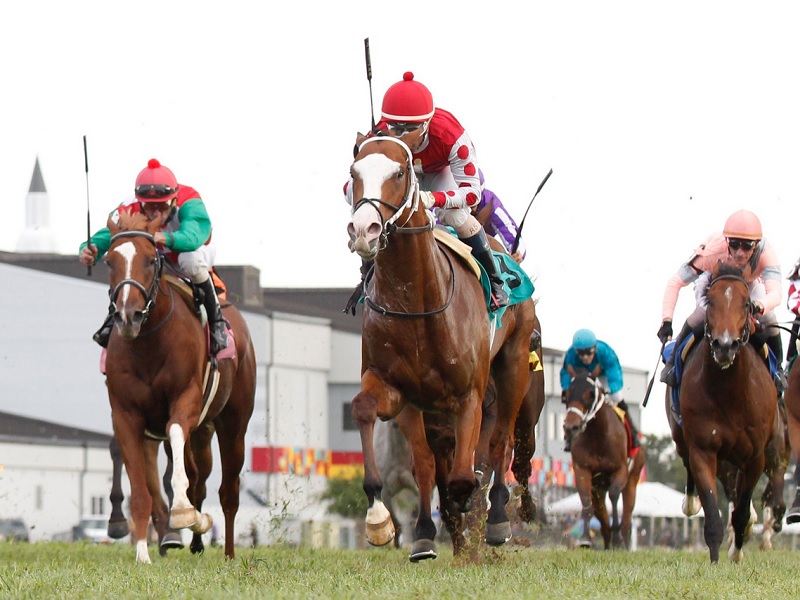by Jeremy Plonk
September 9, 2019

More often than not, claims of track bias are the ‘dog ate my homework’ of handicapping. Unless your Fido has a fixation for physics, such claims merely blur the root cause of your shortcomings – you. It’s not different for horseplayers, who all too often are looking for a reason why they can’t get out of the 20-percentile in picking winners.
Sometimes dogs do eat paper, including your term paper due tomorrow morning. And sometimes track biases do exist. So while we can’t say either is an impossibility, it’s equally fair to say that both are used as an excuse far more often than reality.
Track bias, for the newbies, is when a track surface favors a particular part of the track or running style. They chiefly stem from weather or track maintenance. Think about your own yard. Two things control how it looks and performs – maintenance and Mother Nature. Same goes for racetracks, dirt or turf, just in an inflated square footage. The principal element to a track bias is the depth of the surface (how far a horse gets down into the materials, and, thus, how does that impact the workload and stamina of the horses). But less talked-about creators of track bias include wind and kick-back. Most horses struggle into headwinds, and therefore the pack tends to run in place when faced with one in the stretch. As for kick-back, how much is being thrown in the face of horses racing behind the early speed, and how abrasive are those materials that deter the come-from-behinders?
So much chatter has emerged in recent weeks about the outside bias at Saratoga on the dirt this summer, and more recently the early speed bias at Kentucky Downs on its (only) grass course. You could not find a more common cry against two more uncommon surfaces. Saratoga’s main track was used longer this year than in any recent decade. It’s high-quality horses, many familiar with the footing, and jockeys who know every inch of the surface. At Kentucky Downs, it’s a surface rarely maintained all year long, used for only a literal handful of days annually, and is an undulating grass course void of the conventional crown and banking you’d see on a dirt course. Horses aren’t familiar with it for the most part, and jockeys don’t get many runs over it either.
How pronounced or real were the perceived biases at Saratoga and Kentucky Downs? The sample sizes are limited in giving telling evidence. Like most things in handicapping, we’re left with intuition and repetition as determinants. That is, did it seem like a bias to you? And, if you hear the same thing enough times – true or false – how apt are you to now believe it? (Think of today’s cable news for the latter example.) The echo chamber that is social media certainly has declared biased surfaces at Saratoga and Kentucky Downs.
But determining the validity of those biases isn’t just about “I told you so,” even if that is the driving force behind 99.4 percent of all social media posts. Identifying a real or wrongly accused bias has major next-out implications when betting horses back. Kentucky Downs could be especially important in that regard. Consider they only card a few dozen races per year. You either won, lost or sat on the sidelines. But there will be a few hundred horses come out of those races and appear next at Churchill Downs, Keeneland, Belmont and parts in-between. How many of those horses actually saw their performance aided by a bias, hindered by a bias or were totally given the wrong excuse card from a betting public that misread a bias? The same goes for Saratoga alumni.
Horses who tried to rally on the Kentucky Downs turf this season are going to be given mulligans and forgiveness by many handicappers when they reappear next. The same goes for Saratoga runners who raced on the inside in dirt bids over the so-called 'dead rail.' But just tabbing the results of these next-out runners won’t prove conclusively the perceived biases. The next-out appearances will come over different surfaces, against different fields, and in different spots on the individual form cycle. There are enough new variables to construct an argument as to why a horse runs well or poorly in the reappearance than to simply connect the dots between a fair track today and a biased one a month or so ago. But the echo chamber will be sure to remind you when an example or two backs up their argument from Saratoga and Kentucky Downs. The first few “stuck inside” at Saratoga or “rallied against the speed bias” at Kentucky Downs horses who return to win will be widely lauded as evidence.
Truth is, we’re not going to know, because the Saratoga or Kentucky Downs meets are not long enough to see these horses run back in similar conditions over potentially different footings. If the apples to apples comparisons were available, say in a longer meet, then a handicapper can get a much more confident feel for post-bias evaluation. Longer meets are where you want to ply your trade if you're a big advocate of judging track biases. And when you get good enough to identify real ones, it can be a serious aide to your skill set.
But what you’re likely still left with in this case of Saratoga and Kentucky Downs will be bias evaluation that falls into the aforementioned tools of intuition and repetition. If you think there were real biases, handicap accordingly. If you choose to trust the “everyone seems to be saying it, so it must be true” camp, then be prepared to sink or swim together. But in pari-mutuel wagering, trusting the masses as correct often comes with an under-laid price.